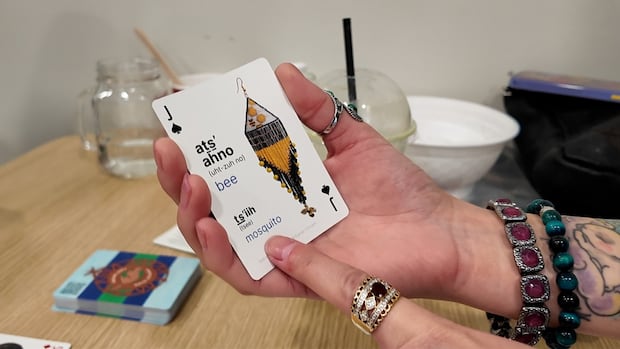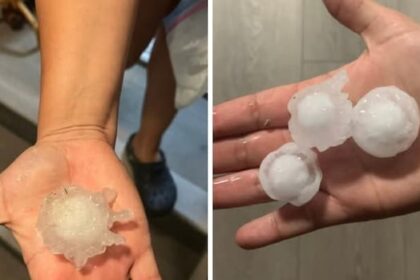North·NewCheyenne Kaiser-Conant, a member of the Prophet River First Nation in northern B.C., says that resources for learning the Beaver language are slim. That’s why she helped create a new tool to help other learners like herself: a deck of playing cards meant to bring the language to life. ‘Words that you can practice every day … is the most important part to get people speaking’CBC News · Posted: Sep 27, 2025 4:00 AM EDT | Last Updated: 30 minutes agoBen Barrett-Forrest, a graphic designer, left, and Cheyenne Kaiser-Conant of the Prophet River First Nation, with a set of playing cards they designed as a resource to learn words in the Indigenous Beaver language. (Gord Loverin/CBC)Cheyenne Kaiser-Conant is not yet fluent in the Beaver language, but she gets a little better with every card game.”I’m working towards it. I grew up with my grandma speaking the language with us, so I can understand some things, mostly like, ‘hey, go turn off that light,’ or, ‘how cold is it?’ or ‘how much is it?’ — and things like that,” she said.Kaiser-Conant, a member of the Prophet River First Nation in northern B.C. and a student of Indigenous governance at Yukon University, says that resources for learning her traditional Indigenous language are slim. That’s why she helped create a new tool to help other learners like herself: a deck of playing cards meant to bring the language to life. “One of the challenges is just being able to practice it more, with more people,” she said. “Being able to use words that you can practice every day … I think is the most important part to get people speaking.”The playing cards were created with the help of Ben Barrett-Forrest, a Victoria-based graphic designer who grew up in the Yukon. He’s developed other illustrated decks of playing cards over the years, and he was excited when Kaiser-Conant approached him with her idea.The 52 cards in the deck include words in the Beaver language with a pronunciation guide, the English translations, and an accompanying illustration. (Gord Loverin/CBC)”She knew I made these decks of playing cards. And so she had the brilliant idea to, ‘wait a second, let’s get Ben in here and see if we can make a really engaging resource using this amazing language and this really keen community,'” Barrett-Forrest recalled.”So then we started working on it.”Kaiser-Conant and Barrett-Forrest enlisted some fellow language and art class students of hers to contribute photos, paintings, or other original artwork to use as illustrations. They settled on a nature theme, and chose the words that would be used.”So then it was just this big brainstorming session where all of the students were throwing out words that they would love to have translated,” said Barrett-Forrest. “And then we kind of edited those down.” The 52 cards in the deck include words in the Beaver language with a pronunciation guide, the English translations, and an accompanying illustration. Kaiser-Conant contributed some of her own beadwork to illustrate the card with the word for “bee.”Kaiser-Conant, a member of the Prophet River First Nation in northern B.C., says that resources for learning her traditional Indigenous language are slim. (Gord Loverin/CBC)”I feel like we have a lot of artistic people in our community and everyone was quite excited about that,” Kaiser-Conant said.They also created an accompanying colouring book and bingo game. In all, there are 190 words with their translations, between the various resources. An initial batch of card decks and bingo games were snapped up, Barrett-Forrest said.”They all disappeared immediately,” he said.The First Nation has also held a few bingo games in the community and the response was “incredible,” he said.”I think that was very heartwarming for the elders in the community to see the old Beaver language being used so enthusiastically by these kids.”Now they’re thinking about developing similar card decks with different themes for the vocabulary, such as things found around the house, or terms for family members. “I think there’s just so much potential to continue releasing these resources,” said Barrett-Forrest. “I think we’ve got a lot of momentum now and it feels like there’s some really exciting potential here.”With files from Leonard Linklater
Tuesday, 11 Nov 2025
Canada – The Illusion
Search
Have an existing account?
Sign In
© 2022 Foxiz News Network. Ruby Design Company. All Rights Reserved.
You May also Like
- More News:
- history
- Standing Bear Network
- John Gonzalez
- ᐊᔭᐦᑊ ayahp — It happened
- Creation
- Beneath the Water
- Olympic gold medal
- Jim Thorpe
- type O blood
- the bringer of life
- Raven
- Wás’agi
- NoiseCat
- 'Sugarcane'
- The rivers still sing
- ᑲᓂᐸᐏᐟ ᒪᐢᑿ
- ᐅᑳᐤ okâw — We remember
- ᐊᓂᓈᐯᐃᐧᐣ aninâpêwin — Truth
- This is what it means to be human.
- Nokoma












